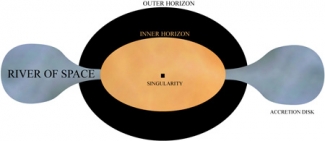Andrew Hamilton and Jason Lisle, who received his Ph.D. in astrophysical and planetary sciences in 2004, have proposed a new model for the flow of matter into stationary and rotating black holes. In their "river model of black holes," space flows like a river through a flat background, while objects (like light rays) that move through the river abide by the rules of special relativity. When a black hole is stationary, the river of space, traveling at the Newtonian escape velocity, falls into it and reaches the speed of light at the outer horizon. Once inside the event horizon, the river flows toward the singularity faster than light, bringing along everything inside it.
If the black hole is rotating, things get slightly more complicated. According to the river model, the river of space still flows through a flat background but does not spiral into the rotating black hole, as we might expect it to. Rather, it falls inward with no azimuthal swirl whatsoever. Instead every point in this river not only has velocity, but it also has a rotation, or twist. In physics terms, the river has a Lorentz structure, with three vectors describing its velocity and three describing its rotation. As objects move in this river, they are buffeted by tidal changes in the speed and twist of the river as it flows along. These tidal effects cause a curvature in spacetime from the perspective of a photon in the river.
Hamilton says the new model is not an alternative theory of gravity. Rather, it's just one way to express the predictions of general relativity. A paper presenting the details of the new model has been accepted for publication in the American Journal of Physics. - Julie Phillips




